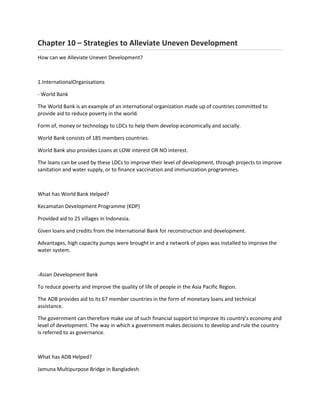
Geography chapter 10 strategies to alleviate uneven development
- 1. Chapter 10 – Strategies to Alleviate Uneven Development How can we Alleviate Uneven Development? 1.InternationalOrganisations - World Bank The World Bank is an example of an international organization made up of countries committed to provide aid to reduce poverty in the world. Form of, money or technology to LDCs to help them develop economically and socially. World Bank consists of 185 members countries. World Bank also provides Loans at LOW interest OR NO interest. The loans can be used by these LDCs to improve their level of development, through projects to improve sanitation and water supply, or to finance vaccination and immunization programmes. What has World Bank Helped? Kecamatan Development Programme (KDP) Provided aid to 25 villages in Indonesia. Given loans and credits from the International Bank for reconstruction and development. Advantages, high capacity pumps were brought in and a network of pipes was installed to improve the water system. -Asian Development Bank To reduce poverty and improve the quality of life of people in the Asia Pacific Region. The ADB provides aid to its 67 member countries in the form of monetary loans and technical assistance. The government can therefore make use of such financial support to improve its country’s economy and level of development. The way in which a government makes decisions to develop and rule the country is referred to as governance. What has ADB Helped? Jamuna Multipurpose Bridge in Bangladesh.
- 2. Aimed at improving the country’s transport infrastructure. Bridge connected to its more developed eastern region. Advantages: Ease traffic congestion, enabling road and rail transport routes to function more efficiently. Hence it encourages economic growth in less developed northwestern region by increasing passenger and goods traffic, improving living conditions through improved infrastructure and removing existing traffic congestion caused by the need to ferry vehicles across the Jamuna River. 2. International Agreements Formed United Nations Millennium Development Goals [UNMDG] Aims to reduce poverty, hunger disease and lack of adequate shelter. Education and environment sustainability also provided. Formed United Nations Convention on the Law of the Sea [UNCLOS] UPDATING SOON!!! 3. Strategies to promote national development in less developed regions. -Improving water supply and sanitation facilities Project in Ahmadebad (do not have access to clean waters which lead to extreme poverty) Parivatan Slum Networking Programme was established to help this region develop. Improve living conditions of slum dwellers, and to provide them with a better quality of life. Slum dwellers were provided with basic infrastructure so that they would have access to clean water supply and underground sewerage, individual toilets and solid waste collection. These would help reduce the spread of diseases caused by bacteria found in waste and contaminated water. Training provided to teach the people in the community about the proper usage of the new facilities, to provent them from getting damaged or to have them repaired if they were not functioning properly. Death rate declined. Fewer people also suffered from general illnesses. Success! -Improving Education standards
- 3. The Hill Tribe Education Project was developed under the government’s policy to provide ‘Education For All’. This project aimed to promote literacy. Formal and informal education programmes were developed to suit the needs of the hill tribe communities. People were taught the Thai Language and Mathematics, basic life and social skills. Volunteer teachers were brought in from the more developed regions to help to teach. Taught about sustainable farming methods and agricultural production to support themselves and improve their standard of living. With education, they are able to find jobs in the cities, which helps increase their incomes. Difficult to reach other hill tribes because of geographical region. 4. Population Control China’s One Child Policy It’s aim was to control the population of China as to avoid being overpopulated. Overpopulation may lead to shortage of resources for the country such as food, employment, house, limited access to education. How? Allowed each couple in China to only have one children. This policy worked well in the cities, but not in rural areas. People living in rural areas tended to have more children for reasons such as having additional help on their farms. Also, couples in China traditionally preferred to have sons compared to daughters, in order to carry on the family name. (child bearing) People in rural areas were exempted. Success. 5. Job creation and financial assistance Linking Arms AgainstPovery (KALAHI) It’s aim is to overcome poverty in Philippines. Microfinance were given to poor people in Philippines for them to make small business.
- 4. Basic skills on business were also taught. This has helped them to increase their income and standard of living. It was a success in reducing povery.
